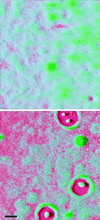Acyl-homoserine lactone quorum sensing in gram-negative bacteria: a signaling mechanism involved in associations with higher organisms
- PMID: 10922036
- PMCID: PMC34013
- DOI: 10.1073/pnas.97.16.8789
Acyl-homoserine lactone quorum sensing in gram-negative bacteria: a signaling mechanism involved in associations with higher organisms
Abstract
Recent advances in studies of bacterial gene expression have brought the realization that cell-to-cell communication and community behavior are critical for successful interactions with higher organisms. Species-specific cell-to-cell communication is involved in successful pathogenic or symbiotic interactions of a variety of bacteria with plant and animal hosts. One type of cell-cell signaling is acyl-homoserine lactone quorum sensing in Gram-negative bacteria. This type of quorum sensing represents a dedicated communication system that enables a given species to sense when it has reached a critical population density in a host, and to respond by activating expression of genes necessary for continued success in the host. Acyl-homoserine lactone signaling in the opportunistic animal and plant pathogen Pseudomonas aeruginosa is a model for the relationships among quorum sensing, pathogenesis, and community behavior. In the P. aeruginosa model, quorum sensing is required for normal biofilm maturation and for virulence. There are multiple quorum-sensing circuits that control the expression of dozens of specific genes that represent potential virulence loci.
Figures




Similar articles
-
Regulation of gene expression by cell-to-cell communication: acyl-homoserine lactone quorum sensing.Annu Rev Genet. 2001;35:439-68. doi: 10.1146/annurev.genet.35.102401.090913. Annu Rev Genet. 2001. PMID: 11700290 Review.
-
Positive Autoregulation of an Acyl-Homoserine Lactone Quorum-Sensing Circuit Synchronizes the Population Response.mBio. 2017 Jul 25;8(4):e01079-17. doi: 10.1128/mBio.01079-17. mBio. 2017. PMID: 28743819 Free PMC article.
-
Quorum sensing signal molecules (acylated homoserine lactones) in gram-negative fish pathogenic bacteria.Dis Aquat Organ. 2005 Jun 14;65(1):43-52. doi: 10.3354/dao065043. Dis Aquat Organ. 2005. PMID: 16042042
-
Production of acyl-homoserine lactone quorum-sensing signals by gram-negative plant-associated bacteria.Mol Plant Microbe Interact. 1998 Nov;11(11):1119-29. doi: 10.1094/MPMI.1998.11.11.1119. Mol Plant Microbe Interact. 1998. PMID: 9805399
-
Quorum sensing in bacteria.Annu Rev Microbiol. 2001;55:165-99. doi: 10.1146/annurev.micro.55.1.165. Annu Rev Microbiol. 2001. PMID: 11544353 Review.
Cited by
-
Detection, characterization, and biological effect of quorum-sensing signaling molecules in peanut-nodulating bradyrhizobia.Sensors (Basel). 2012;12(3):2851-73. doi: 10.3390/s120302851. Epub 2012 Mar 1. Sensors (Basel). 2012. PMID: 22736981 Free PMC article.
-
Transcriptome analysis of the Vibrio fischeri LuxR-LuxI regulon.J Bacteriol. 2007 Nov;189(22):8387-91. doi: 10.1128/JB.00736-07. Epub 2007 Sep 7. J Bacteriol. 2007. PMID: 17827287 Free PMC article.
-
Effects of natural and chemically synthesized furanones on quorum sensing in Chromobacterium violaceum.BMC Microbiol. 2004 Jul 2;4:25. doi: 10.1186/1471-2180-4-25. BMC Microbiol. 2004. PMID: 15233843 Free PMC article.
-
Inactivation of Pseudomonas aeruginosa Biofilms by 405-Nanometer-Light-Emitting Diode Illumination.Appl Environ Microbiol. 2020 May 5;86(10):e00092-20. doi: 10.1128/AEM.00092-20. Print 2020 May 5. Appl Environ Microbiol. 2020. PMID: 32169938 Free PMC article.
-
The luxS gene is involved in AI-2 production, pathogenicity, and some phenotypes in Erwinia amylovora.Curr Microbiol. 2009 Jan;58(1):1-10. doi: 10.1007/s00284-008-9256-z. Epub 2008 Sep 27. Curr Microbiol. 2009. PMID: 18820970
References
-
- Fuqua C, Greenberg E P. Curr Opin Microbiol. 1998;1:183–189. - PubMed
-
- Costerton J W, Stewart P, Greenberg E. Science. 1999;284:1318–1322. - PubMed
-
- Salmond G P C, Bycroft B W, Stewart G S A B, Williams P. Mol Microbiol. 1995;16:615–624. - PubMed
-
- Dunny G M, Leonard B A. Annu Rev Microbiol. 1997;51:527–564. - PubMed
-
- Novick R P, Muir T W. Curr Opin Microbiol. 1999;2:40–45. - PubMed
Publication types
MeSH terms
Substances
Grants and funding
LinkOut - more resources
Full Text Sources
Other Literature Sources

